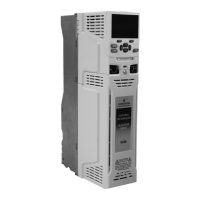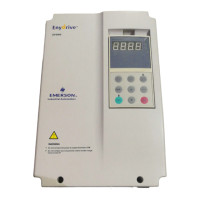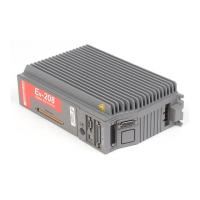Safety
information
Product
information
Mechanical
installation
Electrical
installation
Getting
started
User Menu A Commissioning
Advanced
Parameters
Diagnostics Optimization CT MODBUS RTU Technical Data
468 E300 Design Guide
Issue Number: 1
Over Volts
DC bus voltage has exceeded the peak level or maximum continuous level for 15 seconds
2
The Over Volts trip indicates that the DC bus voltage has exceeded the VM_DC_VOLTAGE[MAX] or
VM_DC_VOLTAGE_SET[MAX] for 15 s. The trip threshold varies depending on the voltage rating of the drive as detailed.
Sub-trip Identification
Recommended actions:
• Check the nominal AC power supply level
• Check the nominal AC power supply for disturbances which could cause the DC bus to rise
• Check external braking resistor circuit is connected
• Check operation of external braking resistor protection
• Check Elevator balanced correctly
• Decrease the braking resistor value staying above the minimum value for drive model)
• Increase the deceleration rate
• Check motor insulation using a insulation tester
Phase Loss AC power supply phase loss
32
The Phase Loss trip indicates that the drive has detected an input phase loss or large AC power supply imbalance. The
drive will attempt to stop the motor before this trip is initiated. If the motor cannot be stopped in 10 seconds the trip occurs
immediately. The Phase Loss trip works by monitoring the ripple voltage on the DC bus of the drive, if the DC bus ripple
exceeds the threshold, the drive will trip on Phase Loss. Potential causes of the DC bus ripple are input phase loss, Large
AC power supply impedance and severe output current instability.
Input phase loss detection can be disabled where the drive is required to operate from either a DC power supply or from a
single phase AC power supply using Input Phase Loss Detection Mode Enable (H08)
Recommended actions:
• Check AC power supply connections
• Check AC power supply fusing
• Check AC power supply voltage balance and level at full load
• Check DC bus ripple with an isolated oscilloscope
• Check the output motor current stability
• Reduce the motor load
• Reduce the duty cycle
• Disable the phase loss detection, set Input Phase Loss Detection Mode Enable (H08) = 2.
Phasing Error RFC-S mode phasing failure due to incorrect phase angle
198
The Phasing Error trip indicates that the phase angle in Position Feedback Phase Angle (C13) is incorrect and the drive is
unable to control the motor correctly.
Recommended actions:
• Check the encoder wiring
• Check the encoder mechanical coupling
• Check the encoder signals for noise with an oscilloscope
• Carry out a autotune OR manually set-up the encoder phase angle in Position Feedback Phase Angle (C13)
• Spurious Phasing Error trips can be seen in very dynamic applications and can be disabled by setting the over-speed
threshold in Motor Over Speed Threshold (E09) to a value > 0.
If sensorless control is being used this indicates that significant instability has occurred and the motor has accelerated
without control.
Recommended actions:
• Ensure motor parameters are set-up correctly.
• Carry out an autotune OR manually set-up the encoder phase angle in Position Feedback Phase Angle (C13)
• Adjust the speed loop gains to reduce the systems dynamic response
Trip Diagnosis
Voltage rating VM_DC_VOLTAGE[MAX] VM_DC_VOLTAGE_SET[MAX]
200 415 410
400 830 815
575 990 970
690 1190 1175
Source xx y zz
Control
system
00 0
01: Instantaneous trip when the DC bus voltage exceeds
VM_DC_VOLTAGE[MAX].
Control
system
00 0
02: Time delayed trip indicating that the DC bus voltage is above
VM_DC_VOLTAGE_SET[MAX].
Source xx y zz
Control
system
00 0
00: Phase loss detected based on control system feedback. The drive
attempts to stop the drive before tripping unless bit 2 of Action On Trip
Detection (H45) is set to one.
Power
system
01
Rectifier
number
00: Phase loss has been detected by the rectifier module

